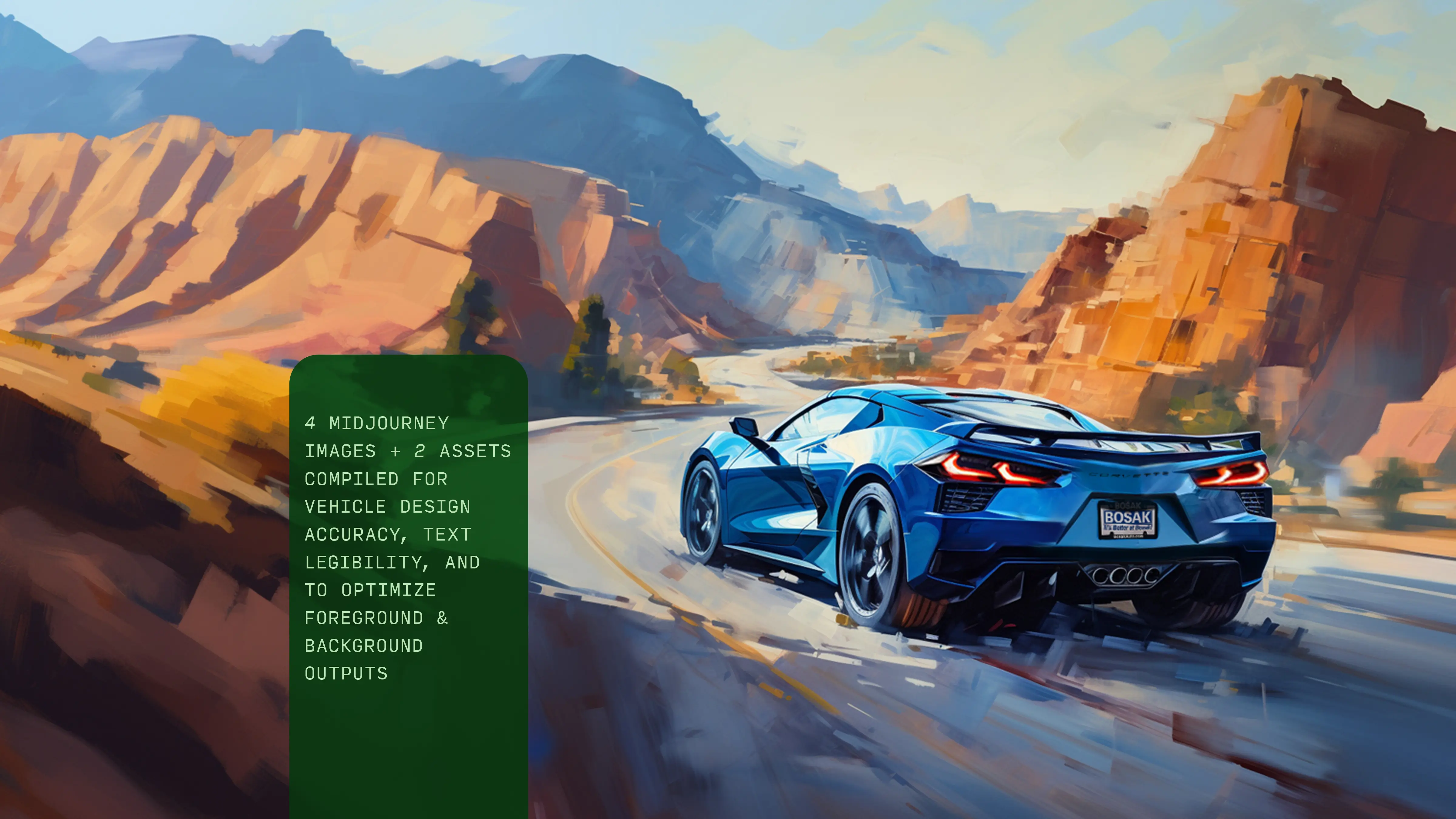
Art comes from the Latin word for craft. The German word for art, Kunst, is related to both knowledge and skill. Artificial intelligence cannot replace either of these things.
Even if it were to be able to create novel work, it fundamentally lacks subjective experience and the ability to use that experience to construct a personally-informed narrative. It is, at the heart of the matter, average.
For people who don't work in the arts, something is often lost in the headlines surrounding artificial intelligence that artists/creatives understand profoundly: The answers are in the work.
Every part of an image, of a design, etc. combine together to make something larger than the sum of its parts. A gestalt. Those connections, however, are unlocked by the process of assembling them. Trying to cut to the end of the line with a perfect prompt impoverishes the idea from the get-go.
For example, the image in the cover photo is a collection of ideas that, together, imparts a concept. It's a photo shot on professional-grade camera equipment that is then edited to replicate Y2K film styles, being that the vehicle is from 2005 and is emblematic of that era's automotive styling. Originally, we had considered a complete Y2K approach, but it felt forced for once reason or another. Kitschy (in a bad way) at worst.
So, we decided to capture the sentiment by broadly aiming for the decorative serif typefaces and metallic effects that were typical of the time, while preserving more textural detail and realism. A quick sketch of where we wanted it to end up was input into Adobe Firefly, giving a photo-real version of the graphic instantaneously. That image was then cut out, adjusted for lighting and color, shadows were added, as well as various other global edits to synchronize the image and make it look complete. The entire process was done in several hours.
For social media, this kind of speed is pivotal to making dynamic work on rapid timeframes. Armed with AI, creative teams can move faster and prioritize content to make sure the best talent isn't bogged down by excessively time-consuming work.
This type of content wouldn't be possible without a tool like this: by the time a brief is set up, an illustrator produces the graphic, and is then placed into the photograph, the vehicle may or may not already have sold. This speed allows marketers to capture a moment better than ever. Considering this time factor and cost efficiency, AI allows for high-quality content to be produced for a broader range of content types, meaning that there are more opportunities for a brand to stand out every time they put a piece of content out into the world.
Given a look under the hood of how AI is used to make engaging content, what is hopefully clear is that AI didn't do the work for us: it simply helped us bring our vision to life faster and cheaper than it would normally be possible. It didn't replace the knowledge and skill required to develop the concept or artfully construct the pieces; nor write the caption and publish the advertising that attracted eyeballs and moved the metal.
Artificial intelligence should amplify human intelligence—as well as the knowledge and skill that supports it.

When a human touch is more important than ever, make sure that your brand is moving towards human ingenuity and authenticity—not away from it.

Art comes from the Latin word for craft. The German word for art, Kunst, is related to both knowledge and skill. Artificial intelligence cannot replace either of these things.
Even if it were to be able to create novel work, it fundamentally lacks subjective experience and the ability to use that experience to construct a personally-informed narrative. It is, at the heart of the matter, average.
For people who don't work in the arts, something is often lost in the headlines surrounding artificial intelligence that artists/creatives understand profoundly: The answers are in the work.
Every part of an image, of a design, etc. combine together to make something larger than the sum of its parts. A gestalt. Those connections, however, are unlocked by the process of assembling them. Trying to cut to the end of the line with a perfect prompt impoverishes the idea from the get-go.
For example, the image in the cover photo is a collection of ideas that, together, imparts a concept. It's a photo shot on professional-grade camera equipment that is then edited to replicate Y2K film styles, being that the vehicle is from 2005 and is emblematic of that era's automotive styling. Originally, we had considered a complete Y2K approach, but it felt forced for once reason or another. Kitschy (in a bad way) at worst.
So, we decided to capture the sentiment by broadly aiming for the decorative serif typefaces and metallic effects that were typical of the time, while preserving more textural detail and realism. A quick sketch of where we wanted it to end up was input into Adobe Firefly, giving a photo-real version of the graphic instantaneously. That image was then cut out, adjusted for lighting and color, shadows were added, as well as various other global edits to synchronize the image and make it look complete. The entire process was done in several hours.
For social media, this kind of speed is pivotal to making dynamic work on rapid timeframes. Armed with AI, creative teams can move faster and prioritize content to make sure the best talent isn't bogged down by excessively time-consuming work.
This type of content wouldn't be possible without a tool like this: by the time a brief is set up, an illustrator produces the graphic, and is then placed into the photograph, the vehicle may or may not already have sold. This speed allows marketers to capture a moment better than ever. Considering this time factor and cost efficiency, AI allows for high-quality content to be produced for a broader range of content types, meaning that there are more opportunities for a brand to stand out every time they put a piece of content out into the world.
Given a look under the hood of how AI is used to make engaging content, what is hopefully clear is that AI didn't do the work for us: it simply helped us bring our vision to life faster and cheaper than it would normally be possible. It didn't replace the knowledge and skill required to develop the concept or artfully construct the pieces; nor write the caption and publish the advertising that attracted eyeballs and moved the metal.
Artificial intelligence should amplify human intelligence—as well as the knowledge and skill that supports it.
When a human touch is more important than ever, make sure that your brand is moving towards human ingenuity and authenticity—not away from it.


Art comes from the Latin word for craft. The German word for art, Kunst, is related to both knowledge and skill. Artificial intelligence cannot replace either of these things.
Even if it were to be able to create novel work, it fundamentally lacks subjective experience and the ability to use that experience to construct a personally-informed narrative. It is, at the heart of the matter, average.
For people who don't work in the arts, something is often lost in the headlines surrounding artificial intelligence that artists/creatives understand profoundly: The answers are in the work.
Every part of an image, of a design, etc. combine together to make something larger than the sum of its parts. A gestalt. Those connections, however, are unlocked by the process of assembling them. Trying to cut to the end of the line with a perfect prompt impoverishes the idea from the get-go.
For example, the image in the cover photo is a collection of ideas that, together, imparts a concept. It's a photo shot on professional-grade camera equipment that is then edited to replicate Y2K film styles, being that the vehicle is from 2005 and is emblematic of that era's automotive styling. Originally, we had considered a complete Y2K approach, but it felt forced for once reason or another. Kitschy (in a bad way) at worst.
So, we decided to capture the sentiment by broadly aiming for the decorative serif typefaces and metallic effects that were typical of the time, while preserving more textural detail and realism. A quick sketch of where we wanted it to end up was input into Adobe Firefly, giving a photo-real version of the graphic instantaneously. That image was then cut out, adjusted for lighting and color, shadows were added, as well as various other global edits to synchronize the image and make it look complete. The entire process was done in several hours.
For social media, this kind of speed is pivotal to making dynamic work on rapid timeframes. Armed with AI, creative teams can move faster and prioritize content to make sure the best talent isn't bogged down by excessively time-consuming work.
This type of content wouldn't be possible without a tool like this: by the time a brief is set up, an illustrator produces the graphic, and is then placed into the photograph, the vehicle may or may not already have sold. This speed allows marketers to capture a moment better than ever. Considering this time factor and cost efficiency, AI allows for high-quality content to be produced for a broader range of content types, meaning that there are more opportunities for a brand to stand out every time they put a piece of content out into the world.
Given a look under the hood of how AI is used to make engaging content, what is hopefully clear is that AI didn't do the work for us: it simply helped us bring our vision to life faster and cheaper than it would normally be possible. It didn't replace the knowledge and skill required to develop the concept or artfully construct the pieces; nor write the caption and publish the advertising that attracted eyeballs and moved the metal.
Artificial intelligence should amplify human intelligence—as well as the knowledge and skill that supports it.
When a human touch is more important than ever, make sure that your brand is moving towards human ingenuity and authenticity—not away from it.